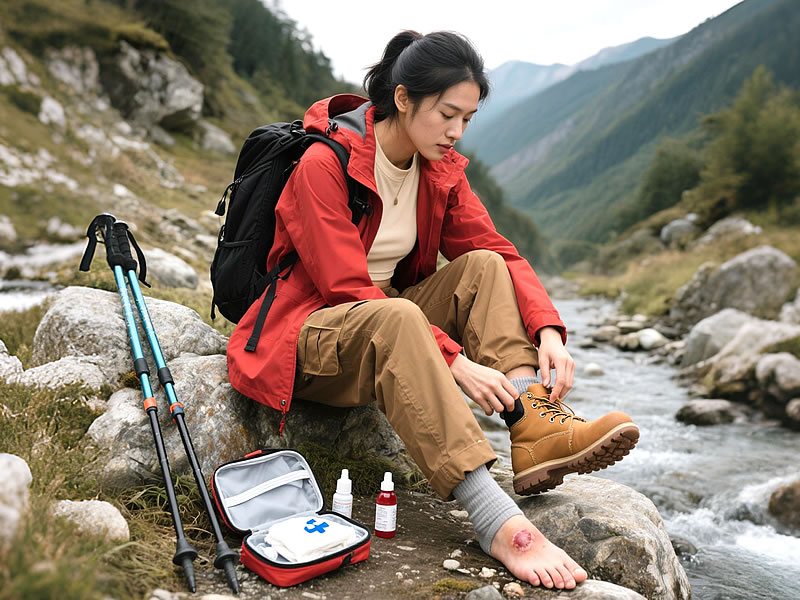How to prevent blisters while hiking?
Blisters aren’t just annoying—they’re the #1 cause of hiking failure on long trails. A 2023 Wilderness & Environmental Medicine study revealed 78% of thru-hikers abandon trips due to foot damage. But with the right prevention strategy, you can keep your feet intact for thousands of blister-free miles.

The Blister Formation Triad (and How to Break It)
Blisters form when three factors converge:
- Heat (friction-induced)
- Moisture (sweat/water)
- Shear Forces (skin layers sliding apart)
Break just one element to prevent blisters.
Phase 1: Pre-Hike Foot Prep
Footwear Selection
| Mistake | Solution |
|---|---|
| "Just my size" boots | Size up ½-1 size (feet swell 8% downhill) |
| Stiff new boots | Break in with 20+ miles urban walking |
| Ignoring last | Trace feet on paper; match boot shape |
✅ Pro Tip: Shop boots afternoon with hiking socks. Toes should wiggle freely.
Sock Science
- Material: Merino wool/synthetic blends > cotton (retains 13x less moisture)
- Layering: Double-layer socks (e.g., WrightSock) separate friction zones
- Seam Placement: Toe seams cause 62% of blisters → choose flat-toe-stitched models
Phase 2: Trail-Ready Defense Tactics
Friction Control System
- Pre-Taping (Gold Standard)Apply Leukotape K (sticks for days) to:HeelsBall of footBig/little toeNo wrinkles!
- Lubricants vs. PowdersHot/dry climates: Antiperspirant + silica powderWet climates: Silicone-based balms (e.g., 2Toms BlisterShield)
- ENGO PatchesAdhesive low-friction patches for shoe interiors → reduces shear by 83%
Moisture Warfare
- Pre-Hike: Soak feet in black tea 20 mins (tannins toughen skin)
- On Trail: Change socks every 4-6 hours (carry 3+ pairs)
- Nuclear Option: Vapor barrier socks in constant wet conditions
Phase 3: Hotspot Emergency Protocol
STOP IMMEDIATELY WHEN YOU FEEL:
- "Warm spot"
- Pinching
- Redness
Field Treatment Steps:
- Clean: Alcohol wipe
- Cover: Hydrocolloid blister pad (e.g., Compeed)
- Reinforce: Leukotape over pad
- Reassess: Check boot lacing (heel lock recommended)
"Never pop blisters in the field—ruptured skin invites infection."— Dr. Laura Grant, Appalachian Trail Medical Director
Blister-Prone Zones & Solutions
| Location | Cause | Fix |
|---|---|---|
| Heels | Boot slippage | Heel lock lacing + ENGO patch |
| Toes | Downhill compression | Toe caps + trim nails straight |
| Ball of Foot | Footbed friction | Metatarsal pads + insoles |
| Achilles | Stiff collar | Moleskin donut + gaiters |
Footwear Hacks by Terrain
- Desert: Trail runners (ventilation) + gaiters (keep sand out)
- Mountains: Stiff-soled boots (reduce flex friction) + custom orthotics
- Wet Trails: Synthetic socks (drain faster) + Sealskinz waterproof socks
Proven Gear Comparison
| Product | Best For | Why It Works |
|---|---|---|
| Leukotape K | Pre-taping | Sticks through sweat, no residue |
| Injinji Liners | Toe blisters | Separate toes, prevent rubbing |
| BodyGlide Foot | Lubrication | Non-greasy, lasts 8+ hours |
| Compeed XL | Existing blisters | Hydrocolloid gel speeds healing |
When Prevention Fails: Field Treatment Kit
- Small Ziplock Containing:Alcohol wipes ×5Blister needles (sterile)Compeed pads (mixed sizes)Leukotape rollTiny tube antibiotic ointment
Final Commandment:
Your feet are your most valuable gear. Stop hourly for foot checks—even if you "feel fine." Memorize this mantra: "Hotspot = Immediate Stop."
"Blisters are preventable engineering failures, not badges of honor."— Andrew Skurka, National Geographic Adventurer






